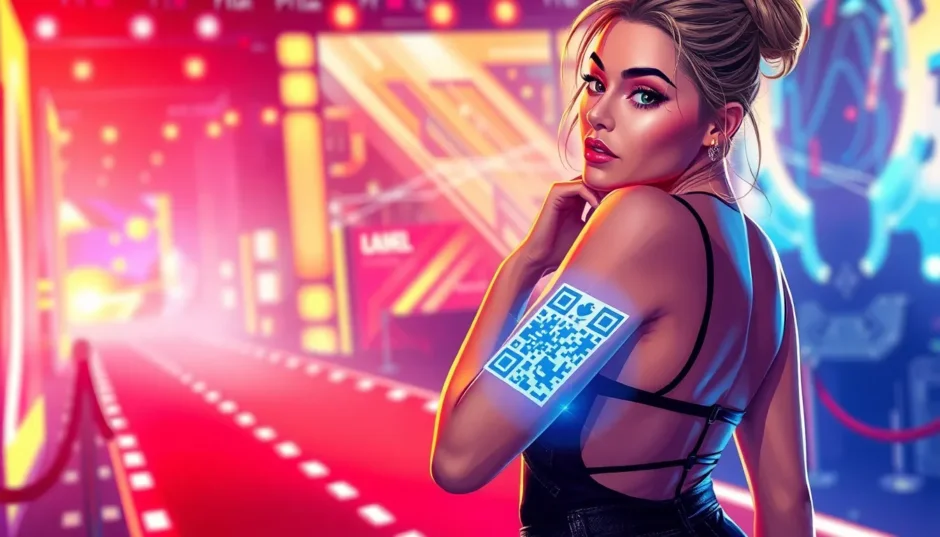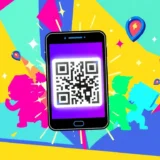When Katy Perry stepped onto the red carpet at the 2024 MTV Video Music Awards, she didn’t just turn heads with her fashion choice—she started a conversation that would spread across social media platforms worldwide. The pop superstar, known for her bold artistic statements, revealed a temporary QR code tattoo on her back that immediately became the night’s biggest talking point.
This wasn’t just any tattoo—it was a functional piece of technology that connected Perry’s physical appearance to her digital content. Fans quickly discovered that scanning the katy perry qr code tattoo link would take them directly to the pre-order page for her upcoming album “143.” The strategic placement and timing of this reveal demonstrated how celebrities can leverage technology to create memorable marketing moments.
Table of Contents
- The VMAs Fashion Statement That Broke the Internet
- Understanding the Katy Perry QR Code Phenomenon
- The Technology Behind QR Code Tattoos
- QR Codes in Celebrity Marketing Strategies
- The Psychology of Interactive Fan Engagement
- The Evolution of QR Code Technology
- Creating Your Own QR Code Campaigns
- The Future of Interactive Physical-Digital Experiences
- Measuring the Impact of QR Code Campaigns
- Ethical Considerations in Interactive Marketing
- QR Codes Beyond Music: Cross-Industry Applications
- Technical Best Practices for QR Code Implementation
- The Role of Social Media in Amplifying QR Campaigns
- Cultural Impact of Technology-Enhanced Celebrity Interactions
- Future Innovations in Interactive Body Art
- Educational Applications of QR Code Technology
- Conclusion: The Lasting Impact of an Interactive Moment
The VMAs Fashion Statement That Broke the Internet
Katy Perry’s entire VMA appearance was carefully curated to make an impact. Her outfit, designed by Who Decides War, featured a deconstructed aesthetic with distressed fabrics and asymmetrical draping that recalled Victorian fashion elements. The ivory-colored ensemble consisted of a one-shoulder bra top and floor-length skirt that gave the impression of being crafted from wet pulp and yarn.
But what truly set this red carpet moment apart was the temporary katy perry qr code tattoo prominently displayed on her back. Unlike permanent tattoos, this was a strategic marketing tool designed specifically for the event. The placement ensured maximum visibility during her red carpet walk and interviews, creating countless opportunities for media coverage and social media shares.
The genius of this approach lies in its interactivity. Instead of simply telling people about her new album, Perry invited them to discover it for themselves. This created a sense of participation and exclusivity that traditional announcement methods simply can’t replicate. Fans weren’t just hearing about new music—they were actively uncovering it through their own curiosity.

Understanding the Katy Perry QR Code Phenomenon
The katy perry qr code represents more than just a clever marketing stunt—it demonstrates the evolving relationship between physical and digital experiences. When fans scanned the code using their smartphones, they weren’t just accessing information; they were participating in a shared experience that connected them directly to the artist.
This approach taps into what psychologists call the “information gap theory”—the idea that curiosity arises when people recognize a gap in their knowledge. By presenting a mysterious code without immediate explanation, Perry created a compelling reason for people to engage with the content. The temporary nature of the tattoo added to its appeal, creating a sense of urgency that encouraged immediate action.
The success of the katy perry qr code tattoo link campaign highlights several important trends in modern marketing. First, it shows that audiences are increasingly comfortable with QR technology. What was once considered a niche tool has become mainstream, with people readily using their phones to scan codes in various contexts. Second, it demonstrates the power of integrating marketing directly into artistic expression, rather than treating it as a separate activity.
iMyFone QRShow.Advanced QR Code Generator – Tracking, Analytics, and Insights.QRShow, our advanced QR code generator, keeps a detailed record of how users scan QR codes and the data they submit on your Dashboard.It tracks scan times, locations, user devices, and the frequency of scans in real-time. This data enables you to gain insights and optimize your campaigns more effectively.
The Technology Behind QR Code Tattoos
Creating a functional katy perry qr code tattoo requires careful planning and execution. Unlike printed QR codes on paper or screens, body-applied codes need to account for skin texture, movement, and lighting conditions. The code must remain scannable despite these challenges, which means testing and optimization are crucial steps in the process.
Temporary tattoos have emerged as an ideal medium for this type of campaign. They offer the visual impact of permanent ink without the long-term commitment, making them perfect for time-sensitive promotions. The application process is relatively simple, and removal is straightforward, allowing for clean execution during high-profile events.
The technical specifications of the katy perry qr code were likely optimized for maximum reliability. This includes error correction settings that ensure the code remains scannable even if portions are obscured or distorted. The size and placement on Perry’s back were probably chosen to provide a large, flat surface that would remain visible and readable throughout the event.
QR Codes in Celebrity Marketing Strategies
Katy Perry’s use of a QR code tattoo is part of a broader trend of celebrities embracing interactive technologies to connect with their audiences. What makes this particular case noteworthy is how seamlessly the technology integrated with her artistic persona and the specific context of the VMAs.
Other artists have used QR codes in different ways—on album covers, in music videos, or during live performances. However, the personal nature of a tattoo creates a more intimate connection between the artist and their fans. It transforms the celebrity’s body into a living, interactive platform, blurring the lines between personal expression and promotional activity.
The viral impact of the katy perry qr code demonstrates the power of surprise in cutting through the noise of modern media. In an era of information overload, unexpected and interactive elements can capture attention in ways that traditional announcements cannot. The social media buzz generated by curious fans sharing their discoveries amplified the reach of the campaign far beyond the immediate VMA audience.
The Psychology of Interactive Fan Engagement
The success of the katy perry qr code tattoo link campaign can be understood through several psychological principles. The element of mystery triggered curiosity, motivating fans to take action to resolve their uncertainty. The interactive nature of scanning the code created a sense of agency, making fans feel like active participants rather than passive recipients of information.
This approach also leveraged the power of social proof. As fans saw others discussing and scanning the code, they felt compelled to join the conversation. The shared experience of discovery created a sense of community among fans, strengthening their connection to both the artist and each other.
The temporary aspect of the tattoo added scarcity to the equation. Unlike digital content that remains available indefinitely, the opportunity to interact with the code in its original context was time-limited. This created a sense of urgency that encouraged immediate engagement rather than postponement.
The Evolution of QR Code Technology
QR codes have come a long way since their invention in 1994 by the Japanese company Denso Wave. Originally developed for tracking automotive parts, these two-dimensional barcodes have evolved into versatile tools for connecting physical and digital experiences. The technology’s ability to store large amounts of data in a small space makes it ideal for creative applications like the katy perry qr code.
Modern QR codes offer several advantages over earlier versions. Improved error correction means they can be scanned successfully even when partially damaged or obscured. Design flexibility allows for customization that aligns with brand aesthetics while maintaining functionality. And with smartphone cameras now equipped with built-in QR scanning capabilities, the barrier to usage has virtually disappeared.
The adoption rate of QR technology has skyrocketed in recent years. Research indicates that in 2022 alone, user-generated QR codes were scanned more than 6.8 million times globally—an increase of 433% from the previous year. This widespread acceptance has created opportunities for innovative applications across industries, from retail to entertainment.
iMyFone QRShow.Advanced QR Code Generator – Tracking, Analytics, and Insights.QRShow, our advanced QR code generator, keeps a detailed record of how users scan QR codes and the data they submit on your Dashboard.It tracks scan times, locations, user devices, and the frequency of scans in real-time. This data enables you to gain insights and optimize your campaigns more effectively.
Creating Your Own QR Code Campaigns
The success of the katy perry qr code tattoo provides valuable lessons for marketers and content creators looking to implement similar strategies. The first consideration is context—the QR code should feel like a natural extension of the overall experience rather than a tacked-on promotion. Perry’s code worked because it aligned with her innovative image and the technological theme of the VMAs.
Placement and visibility are also critical factors. The code needs to be easily accessible and scannable, with consideration given to lighting, angle, and potential obstructions. Testing under realistic conditions is essential to ensure reliability. The size of the code should balance visibility with aesthetic considerations, large enough to scan easily but not so large that it becomes distracting.
Content strategy is another important element. The destination of the katy perry qr code tattoo link should provide value that justifies the effort of scanning. In Perry’s case, fans were rewarded with early access to album pre-orders, creating a clear benefit for their participation. The experience should feel rewarding rather than transactional, building positive associations with the brand or artist.
The Future of Interactive Physical-Digital Experiences
Katy Perry’s QR code tattoo offers a glimpse into the future of marketing and audience engagement. As augmented reality and other immersive technologies continue to develop, we can expect to see even more innovative ways to bridge physical and digital experiences. The success of this campaign demonstrates the public’s readiness to embrace these hybrid interactions.
The entertainment industry is particularly well-positioned to benefit from these developments. Concerts, award shows, and other live events provide perfect opportunities for interactive elements that enhance the audience experience. The katy perry qr code shows how these technologies can extend the reach of an event beyond its physical location, creating connections with remote viewers.
Looking ahead, we may see more personalized and dynamic uses of QR technology. Instead of static codes that always lead to the same destination, future applications could offer context-aware content that changes based on time, location, or user preferences. This would create even more engaging and relevant experiences for audiences.
Measuring the Impact of QR Code Campaigns
The success of interactive campaigns like the katy perry qr code can be measured through several key metrics. Scan rates provide immediate feedback on engagement levels, while subsequent actions—such as pre-orders in Perry’s case—indicate conversion effectiveness. Social media mentions and shares offer insights into viral reach and audience sentiment.
Advanced analytics can provide deeper understanding of user behavior. Tracking scan times reveals when engagement peaks, helping to optimize timing for future campaigns. Geographic data shows where interest is concentrated, informing regional marketing strategies. Device information helps ensure compatibility across different platforms and operating systems.
Long-term impact can be assessed through brand sentiment analysis and customer loyalty metrics. Successful interactive campaigns often create positive associations that extend beyond the immediate conversion, building stronger relationships between artists and their fans. The memorability of unique experiences like scanning a celebrity’s tattoo can create lasting impressions that traditional advertising struggles to match.
Ethical Considerations in Interactive Marketing
As technologies like QR codes become more sophisticated and integrated into personal spaces, ethical considerations become increasingly important. The personal nature of a tattoo—even a temporary one—raises questions about the boundaries between promotion and personal expression. The katy perry qr code navigated this territory by aligning with the artist’s established brand and providing clear value to fans.
Transparency is another key consideration. Users should understand what will happen when they scan a code and what data might be collected in the process. Perry’s campaign was straightforward—fans knew they were accessing album information—but more complex interactions may require clearer communication about data usage and privacy.
Accessibility should also be considered in interactive campaigns. While smartphone penetration is high, not all users may be comfortable with QR technology or have devices capable of scanning codes easily. Providing alternative access methods ensures inclusivity and maximizes reach beyond the tech-savvy segment of the audience.
QR Codes Beyond Music: Cross-Industry Applications
The principles demonstrated by the katy perry qr code tattoo have applications far beyond the music industry. Fashion brands could use similar approaches during runway shows, allowing attendees to scan codes on clothing to learn about materials, pricing, or availability. The temporary nature of the tattoos would align perfectly with the ephemeral quality of fashion trends.
In the film industry, QR codes could appear in promotional materials or even within movies themselves, creating interactive storytelling experiences. Imagine scanning a code that appears briefly in a scene to access bonus content or alternative storylines. This would add layers of engagement to the viewing experience.
Museums and galleries could use QR code tattoos on performers or guides to provide additional context about exhibitions. Educational institutions might apply similar techniques to make learning more interactive and memorable. The potential applications are limited only by creativity and willingness to experiment with new forms of audience engagement.
iMyFone QRShow.Advanced QR Code Generator – Tracking, Analytics, and Insights.QRShow, our advanced QR code generator, keeps a detailed record of how users scan QR codes and the data they submit on your Dashboard.It tracks scan times, locations, user devices, and the frequency of scans in real-time. This data enables you to gain insights and optimize your campaigns more effectively.
Technical Best Practices for QR Code Implementation
Creating successful QR code campaigns requires attention to technical details that ensure reliability and user satisfaction. Error correction settings should be optimized for the specific application—higher levels for codes that might be partially obscured or distorted, like the katy perry qr code tattoo on moving skin.
Size considerations are particularly important for physical applications. The code must be large enough to scan easily but proportionate to its context. Testing with multiple devices and scanning apps helps identify potential compatibility issues before public rollout. Lighting conditions at the scanning location should be considered during design, with sufficient contrast between the code and its background.
The destination URL should be optimized for mobile devices, with fast loading times and intuitive navigation. There’s nothing more disappointing than successfully scanning an intriguing code only to encounter a poorly formatted or slow-loading webpage. The user experience from scan to content consumption should be seamless and rewarding.
The Role of Social Media in Amplifying QR Campaigns
The viral spread of the katy perry qr code demonstrates how social media can amplify interactive campaigns. As fans shared their discoveries and experiences online, they effectively became brand ambassadors for the album launch. This organic reach extended far beyond the initial VMA audience, generating buzz across multiple platforms.
Successful QR code campaigns often include built-in social sharing incentives. This might involve exclusive content worth sharing or interactive elements that naturally encourage discussion. The mysterious nature of Perry’s tattoo created inherent shareability—people wanted to show others what they had discovered and explain how it worked.
Timing social media support around QR code revelations can maximize impact. Coordinated posts from the artist’s official accounts, combined with organic fan content, create a wave of attention that drives engagement. Hashtags and other social media tools help track conversation spread and sentiment, providing valuable feedback for future campaigns.
Cultural Impact of Technology-Enhanced Celebrity Interactions
The katy perry qr code tattoo represents a shift in how celebrities interact with their audiences. Rather than maintaining distance and mystery, modern artists are finding ways to create more immediate and personal connections through technology. This democratization of access changes the dynamic between stars and their fans.
There’s also a cultural statement in using technology as a form of bodily decoration. The katy perry qr code tattoo link literally wrote digital language onto human skin, symbolizing the increasingly blurred boundaries between our physical and digital identities. This fusion of technology and personal expression reflects broader cultural trends toward digital integration in all aspects of life.
The temporary nature of the tattoo also comments on the ephemeral quality of modern media moments. In an age of endless digital content, creating physical experiences that exist only for a limited time creates specialness and urgency. The memory of having scanned Perry’s tattoo may linger long after the code itself has faded.
Future Innovations in Interactive Body Art
Looking beyond the katy perry qr code, we can imagine future developments in interactive body art. Technologies like NFC chips or RFID tags could be incorporated into temporary tattoos, allowing for more complex interactions than simple URL redirection. These could enable two-way communication or context-aware responses.
Augmented reality overlays could transform how we perceive body art entirely. Instead of static codes, temporary tattoos might serve as markers that trigger immersive digital experiences when viewed through AR-enabled devices. This would create magical moments where the physical and digital worlds blend seamlessly.
Biometric integration could take interactive body art in even more personal directions. Tattoos that respond to physiological signals like heart rate or body temperature could create living artworks that change in response to their wearer’s state. While these applications might be further in the future, the katy perry qr code shows the public’s readiness to embrace technology-enhanced body decoration.
Educational Applications of QR Code Technology
The engagement demonstrated by the katy perry qr code campaign has implications beyond entertainment marketing. Educational institutions could apply similar principles to make learning more interactive and engaging. Temporary tattoos with QR codes could be used during school events or museum visits to provide additional information in a fun, memorable way.
Language learning represents another potential application. QR codes placed on objects could provide pronunciation guides or cultural context when scanned. This would create immersive learning experiences that connect physical objects with digital resources, much like the katy perry qr code connected a physical appearance with digital content.
Professional training and development could also benefit from QR integration. Temporary tattoos or badges at conferences could facilitate networking by providing quick access to contact information or professional profiles. The interactive element would encourage engagement while simplifying information exchange.
Conclusion: The Lasting Impact of an Interactive Moment
Katy Perry’s QR code tattoo at the 2024 VMAs represents more than a clever marketing stunt—it signals a shift in how artists connect with audiences in the digital age. By transforming her body into an interactive platform, she created a memorable experience that blurred the lines between physical appearance and digital content.
The success of the katy perry qr code tattoo link campaign demonstrates the power of curiosity and participation in cutting through the noise of modern media. It shows that audiences are ready and willing to engage with technology in personal and unexpected ways. And it proves that the most effective marketing often doesn’t feel like marketing at all, but rather like an invitation to share in a special experience.
As technology continues to evolve, we can expect to see more innovative applications that bridge physical and digital experiences. The katy perry qr code has set a high bar for creativity and engagement, inspiring marketers and artists across industries to think differently about how they connect with their audiences. The future of interactive experiences looks bright, limited only by our imagination and willingness to experiment with new
 TOOL HUNTER
TOOL HUNTER



